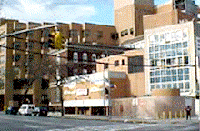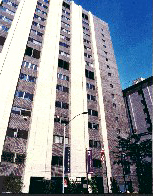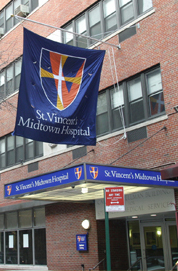Wireless And Emergency Response
This month has seen several reminders of the failures associated with September 11, 2001, including technological failures, and the long efforts to make sure they do not happen again.
The city’s new emergency operations center opened in Downtown Brooklyn. The primary goal of the new center is to utilize advanced technologies to improve coordination of emergency response efforts in the case of a large-scale disaster .
The federal Environmental Protection Agency announced new plans for a final cleanup in lower Manhattan of buildings contaminated by dust after the terrorist attack –- plans that Senator Hillary Rodham Clinton and others called inadequate. Although this is primarily a political and public health debate, technological shortcomings lie at the heart of it. Previous cleanup efforts failed because the agency was unable to distinguish reliably between trade center dust and other contaminants .
Starting next month, police, firefighters and other emergency responders will have for their use a new high speed wireless data network, at first activated only in lower Manhattan, but due to spread throughout the city by the Spring of 2008. In effect, New York City is investing $500 million with the defense and technology company Northrop Grumman to ensure that the communications breakdowns that occurred on September 11, 2001 never happen again .
9/11 Communications Breakdowns
As has been well documented, there were several communications failures on September 11, 2001. Although both police officers and firefighters responded heroically, there is no doubt that inadequate communications caused unnecessary deaths.
Many fire department radios either did not work at all, or only intermittently. Radios did not work well in high-rise buildings, subways or tunnels, and firefighters had difficulty determining which channel to use to relay information. Even with perfect communications equipment, the chaos on September 11 would have caused tremendous mayhem and carnage. But the equipment was far from perfect.
On the whole, police department radios were more reliable than the fire department’s radios. But police transmissions were hard to decipher in the immediate aftermath of the attack. Officers attempted to use their cell phones, but this was an unreliable mode of communication as well.
Since September 11 both the Police and Fire Departments have improved their communications capabilities. The Fire Department in particular has upgraded its radios, and invested in better equipment for boosting radio signals to the upper floors of high rise buildings.
Handheld radios are likely to remain the tool of choice for first responders for the next several years. But even the most sophisticated radio feels somewhat antique in our technologically advanced age.
City Hall’s contract with Northrop Grumma, to build a first-ever Citywide Mobile Wireless Network, will greatly enhance emergency response capabilities.
The Citywide Mobile Wireless Network
In September, the Bloomberg administration announced that Northrop Grumman had won a five-year contract to build the Citywide Mobile Wireless Network. The company defeated rival Motorola to capture the bid.
The wireless network will allow emergency responders to transmit information efficiently from state and federal anti-terrorism databases, as well as mug shots, fingerprints, and even streaming video. If necessary, information could be shared with multiple agencies simultaneously. During times of crisis, police officers, firefighters, and personnel from the Office of Emergency Management should be assured of reliable two-way communication between first responders on the scene and response managers at remote locations. And during routine periods, these enhanced capabilities should streamline communications and improve emergency response times. The network will be designed with the flexibility to work in sections of the city where wireless access is less reliable.
“One of the most important lessons learned from the September 11th attacks was that our emergency responders need better access to information and clearer lines of communication in the field,” Mayor Bloomberg said. In that spirit, a critical aspect of the new wireless network is that everyone in the emergency response arena will utilize it. This baseline fact should mitigate against departmental turf wars.
Northrop Grumman is scheduled to deliver a fully functioning wireless network by the spring of 2008. After that time, the company will maintain the network and provide appropriate upgrades. If the project proves a success, city officials have the option to renew the contract for up to 10 additional years.
Public Safety -- NYC's Niche For Wireless?
With the Northrop Grumman contract, City Hall clearly aims to be on the forefront of public safety wireless initiatives. Indeed, New York claims that this is the “most aggressive public safety technology initiative of any municipality.”
Some are skeptical since New York has moved much less aggressively than other cities to provide free or inexpensive wireless access to tourists and residents. Indeed, Information Technology and Communications Commissioner Cosgrave argues that it is not “feasible or necessary” to provide wireless access throughout the city.
Wireless activists and government officials will continue to debate the appropriate extent of public wireless access, and the ultimate results of that discussion are unclear. What seems more certain is City Hall’s desire to fill a specific niche as the leader in the use of wireless technology for public safety.
Â
Twin Crises In Health Care
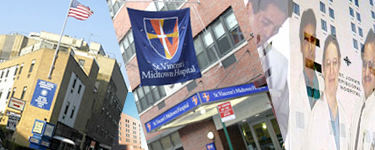
Five more NYC hospitals are slated to be closed
St. Mary's Hospital in Central Brooklyn closed its doors in the summer of 2005, succumbing to long standing financial pressures. The emergency rooms in nearby hospitals were suddenly packed; patients in St. Mary’s mental health and detoxification units were forced to travel over an hour away to a hospital in Jamaica, Queens; and some patients simply stopped getting treatment they had been receiving at St. Mary’s, said Jin Hee Lee, who works against hospital closings for the New York Lawyers for the Public Interest. The closing caused a crisis that, she argues, may soon be repeated in other neighborhoods in New York City.
The Commission on Health Care Facilities in the 21st Century, a powerful state panel set up to restructure health care in New York State, recommended closing five more hospitals in New York City when it published its report on November 28. It wants 10 others to change the services they provide.
"What happened in Central Brooklyn is a precursor of what could happen to other communities affected by hospital closures," said Hee Lee.
But not everyone saw the closing of St. Mary's in such stark terms. At nearby Interfaith Hospital, which was also suffering financially, the closing did indeed cause a surge in patients. But if the hospital was overwhelmed at first, it was soon able to increase its own services to handle these new patients. Interfaith broke even for the first time in recent history last year, and expects to turn a small profit in 2006.
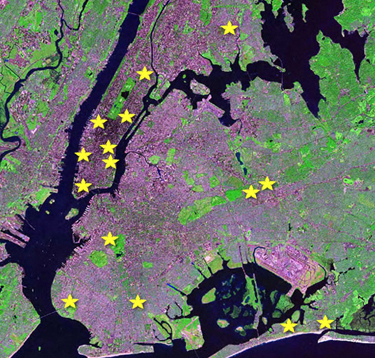
NYC Hospitals Scheduled For Closing Or Restructuring
Click on map for a larger version and more details.
"We were the beneficiaries," said Interfaith spokesperson Melissa Krantz.
The differing views illustrate the complexity of the problem facing the health care system. In fact, there are two health care crises facing New York.
• Fragile Finances: Melissa Krantz's perspective comes from her experience at an institution that is financially unstable – one common to those working in hospitals. Money problems plague the state's hospitals, and have led 12 hospitals in the city to close in the last 10 years.
• Lack of Access to Care: Jin Hee Lee, on the other hand, sees the shocking lack of care (report in pdf format) available to many New Yorkers -– 13 neighborhoods have been designated "health care professional shortage areas," and over half of the city's zip codes have an inadequate supply of primary care physicians willing to see Medicaid patients.
Big changes are in store for New York's health care as the commission attempts to fix the state's ailing health care system. Its report is being described as "probably the most massive, dramatic, impactful reorganization of health care in New York State", and "one of the most important documents to hit Albany in years." And it is being billed as only the first step in a fundamental change in the way New Yorkers get medical care.
Whether these changes will fix either of the two crises facing New York health care is a question that will likely take years to answer.
CHANGES IN HEALTH CARE
|
Victory Memorial Hospital , Brooklyn |
Because state laws and regulations guide the shape of the health care system, many trends in health care happen on the state level. In New York, that system is big. The state has an extensive hospital system that has been built up over a century by philanthropists, religious groups, and the government itself, and the country's largest Medicaid program, a public insurance program serving the poor. Both the Medicaid and the hospital system are seen as unsustainable.
Medicaid: Four million New York State residents are insured through Medicaid, a public insurance program for the poor. Two million people additional people in New York City alone lack any health insurance, even though they may be eligible for Medicaid. There is a push to increase enrollment among people who are eligible for Medicaid but currently uninsured.
But at $45 billion annually, New York's Medicaid system is an enormous expense that strains both state and local coffers, since the two levels of government split the cost. Officials in Albany are being pulled both to increase coverage and reduce the overall cost of the program.
Hospitals: There are about 200 hospitals in New York State, and about 70 in New York City. They are the most visible part of the health care system, with their emergency rooms, wards of beds for patients, and large staffs of doctors and nurses. But an increasing amount of care is actually being provided in other settings. Clinics that don't have the capacity to do the heavy lifting – complicated surgery, elaborate testing, overnight stays – are able now to provide an increasing amount of care that in the past required hospital stays. Many people receive all their health care from private doctors or small clinics, only seeing the inside of a hospital if they become seriously ill or badly injured. Fewer procedures are done in hospitals, and the average length of hospital stays is dropping.
For people suffering from a range of health problems, care at clinics is more comfortable, safer, and cheaper. AIDS patients, for instance, were likely to spend long periods of time in the hospital during the 1980s, but now the disease is treated largely at community clinics, allowing the patients to live relatively normal lives. As a result, hospitals are not as central to the health care system as they once were.
New York is having trouble adjusting to this change, experts say. There are 3.3 hospital beds per 1,000 people in the state, putting it above the national average of 2.8 beds per 1,000 people in the country as a whole (though much lower than some other states, like South Dakota, which has 6 beds per 1,000 people). The average hospital stay in New York State is 1.2 days longer than the national average; in New York City the stay is a full two days longer, according to the commission.
While the structure of New York's health care system may guarantee that hospitals keep a central role, it does not ensure that the hospitals remain financially viable. In fact, there is wide agreement that New York's hospital industry is near collapse.
FINANCIAL TROUBLES IN NEW YORK HOSPITALS
|
Cabrini Medical Center, Manhattan |
As a whole, the state's hospitals have lost money for eight consecutive years, and bled $2.4 billion since 1998. Individually, only one of every 10 hospitals statewide makes enough money to properly reinvest in infrastructure and update their services, according to a recent report from the Healthcare Association of New York State. Over 30 hospitals have closed in the last ten years, 12 of those in New York City. Several more have filed for bankruptcy.
The main task of the Berger commission – as the panel is known – was to address this financial crisis. It acted on what it sees as the major reason for the squeeze – the glut of hospitals in the state – while leaving other tasks to be dealt with in the future.
The Berger Commission: Too Many Hospitals
The Berger commission began its work from the assumption that the supply of hospitals in New York State far outpaces demand. The occupancy rate in the state's hospitals dropped 17.5 percent between 1983 and 2004, and the panel estimates that as many as one-third of the state's hospitals beds are empty on any given day. Further, hospitals continue to provide many services that could be provided less expensively in outpatient clinics. This view is shared by a wide range of experts, including hospital trade groups and health care workers unions who have long been the major opponents of hospital closings.
Berger has repeatedly insisted that he is not operating a "hospital closing commission." But from its inception, the structure of the panel was designed to provide political cover to state officials undertaking this unpopular task. The legislature does not have to approve the report – if it does not act by the end of the year the recommendations become law – so no lawmaker will have to vote to close a hospital in his or her district. The recommendations can only be rejected in full, meaning that the legislature may not pick and choose. Finally, a federal Medicaid waiver worth $1.5 billion is tied to the state's enactment of the plan, meaning lawmakers would have to choose to forgo this money in order to reject the commission's recommendations.
As expected, the main feature of the commission's report was a list. Nine hospitals, it said, should close, and an additional 48 that should downsize or otherwise reorder the services they provide. If accepted, the recommendations will affect about one quarter of the state's hospitals, including fifteen in New York City. The changes to the city's hospitals would reduce the number of hospital beds by eight percent.
The intention of the hospital closings and reconfigurations is to eliminate duplicative services, which in theory will make the system as a whole more efficient. With unneeded beds eliminated, hospitals will operate closer to capacity, leaving them more financially sound. In areas with many hospitals, the commission believes that closing one will ease the financial strain on the others, leaving them better able to care for patients.
For example, New York Methodist Hospital and New York Community Hospital in Brooklyn now compete for patients, but neither provides ambulatory (outpatient) services. The commission would have the two hospitals merge into a single institution, eliminating about 100 beds between them, and using the space to create an outpatient clinic.
Both Governor George Pataki and incoming Governor Eliot Spitzer have said they support the commission's plan, and the major health care unions and trade groups that could have mobilized a serious campaign against them have indicated they will not do so. This makes it almost certain to become law.
Will Restructuring Hospitals Save Money?
|
Parkway Hospital, Queens |
Yes
All of this will save significant sums, the commission believes. Berger estimates that these changes will save $1.5 billion a year. Health care providers will save about $720 million annually, while public and private insurers will save $800 million each year. The annual savings for Medicaid alone is expected to save about $250 million.
Berger estimates that it will cost $1.2 billion to make these changes. Between the Medicaid waiver, known as FSHRP, and another pool of state money, HEAL-NY, there is about $2.5 billion available to implement the plan.
Not everyone agrees with the recommendations, however.
No
Alan Sager, a professor of public health at Boston University who has studied hospital closings in cities across the country, says that the cost of empty beds has been vastly overstated. Calling closings "a diversion, not a policy," Sager notes that closing hospitals has been used as a cost-saving measure in many places, including New York, yet health care costs continue to rise. Closing hospitals may be good for the bottom line of neighboring hospitals, he argues, but it could actually make health care more expensive overall.
"Consolidation would mean less price competition among hospitals," wrote Sager in a recent report. "That would bolster hospitals' bargaining positions, allowing hospitals to raise prices."
Daniel Sisto of the Healthcare Association of New York State said that the commission has significantly underestimated the cost of actually closing hospitals, describing its figures as " ludicrous." (in pdf format.)
Other critics agree with the underlying philosophy of the commission, but, like the New York Post, say it " punted " by making modest recommendations that won't put remaining hospitals on firm ground. By closing only seven percent of the hospital beds in the state, they argue, the commission has bowed to political pressure instead of making the changes necessary to fix the finances of the system as a whole.
"The commission should have called for tougher medicine - more closures, more mergers, more service-sharing, etc.," wrote Steven Malanga of the Manhattan Institute.
Berger acknowledged that the commission didn't eliminate all of the excess capacity it sees in the system. He says that more hospitals beds will have to be eliminated in the future. But closing more hospitals now would have been "massively destabilizing," he argued. There are other things that must be done first.
The Next Step: How Hospitals, Clinics, and Doctors are Paid
The Berger commission says its recommendations for specific hospitals are a way of dealing with the symptoms of the problem that have caused the financial crisis in New York's health care system. "It is equally or more critical to also address the 'root causes'," it writes in its report.
Stopping the Medical "Arms Race"
The next issue to be dealt with, says Berger, is the way health insurance companies pay health care providers – hospitals, clinic, and individual doctors – for the services they provide. Insurers determine the rates that they will pay a hospital for carrying out cardiac surgery, for instance, or for a clinic doing an annual checkup on a diabetes patient. Private health insurance companies negotiate rates with individual health care providers; the state sets the rates for Medicaid. This has great influence over the shape of the health care system, because it creates incentives to provide certain types of care and discourages others. Health care experts from all ends of the political spectrum see so-called reimbursement as an area that is ripe for change.
One major way that reimbursement has distorted the health care system, experts say, is by paying very well for high-tech, invasive procedures like brain surgery. Necessary services such as primary care pay low margins by comparison. This results in a "medical arms race," where the hospitals that can afford to make the investment in complicated technologies compete to provide services that may or may not be necessary while ignoring less profitable ones. Hospitals that cannot do so, meanwhile, are left to struggle financially with the money they earn from simpler procedures.
This has left some vital hospitals in dire financial straits. The commission cites New York Downtown Hospital as a prime example. It is the only hospital in lower Manhattan, but because its main operations are maternity care and an emergency room that serves a largely uninsured population, it is on the brink financially.
Creating Options for Non-Hospital Care
The current patterns of reimbursement were developed with hospitals in mind. This can make it difficult for health care providers to offer services in non-institutional settings. Even when hospitals have their own clinic where they believe patients could be treated more appropriately, they can't always afford to do it, said Sharon Salit of the United Hospital Fund.
"Hospitals, as status quo as they may seem, really do want to move patients out of the hospital and treat them in an outpatient setting," she said. "Their hands are tied."
How Can New York Change Reimbursement Patterns?
|
New York Westchester Square Medical Center, Bronx |
In the mid 1990s New York State ceded control over the rates that private companies set, so its control over reimbursement is limited to the rates it determines for Medicaid. While New York has no direct control over the rates set by private insurers, experts say its Medicaid rates do serve as a basis for how much private companies charge.
The law through which the state sets Medicaid rates – the Health Care Reform Act – is up for renewal in June, so Governor Spitzer and the legislature will have a chance to deal with this issue soon. This is likely to be a difficult political subject. Any increase in the amount Medicaid pays for primary care must either come with a reduction in the rates for other services, or an increase in the overall Medicaid budget. Spitzer has promised to cut the cost of the Medicaid system.
Others, meanwhile, want to see the burden shifted from struggling hospitals to the thriving health insurance industry. The City Council says that the state's deregulation has "largely failed to produce positive results for health care institutions". It published a report in November (in pdf format) recommending partially re-regulating the insurance industry, to make sure that insurers don't pay hospitals less than it costs the hospital to provide services.
A LACK OF ACCESS TO HEALTH CARE
The discussion surrounding the Berger commission has focused largely on how to pull the state's hospital system out of its current financial insecurity. New York officials regularly discuss how best to bolster industries whose financial success is important to the state's economy – retaining Wall Street firms, for example, or supporting what is left of the manufacturing industry.
From a purely economic standpoint, health care does rank among the state's most vital industries. But critics say that in its focus on the finances of the hospital system, the current debate has neglected the most serious health care problem facing the state: the lack of access to health care for millions of New Yorkers.
Critics of the commission do see some of their priorities reflected in its final report, which calls for:
• "Reimbursement reform" that would encourage preventive care and create incentives for serving vulnerable populations;
• Helping uninsured New Yorkers enroll in public health insurance programs; and
• Increasing access to primary care
These policy recommendations, unlike those pertaining to specific hospitals, are not binding. Whether these "idealized" principles are turned into policy, says William Van Slyke of the Health Care Association of New York State, is "the million dollar question" that will determine whether the Berger Commission is a success or a failure.
Others are more critical, saying that the commission has only paid lip service to these issues, and has completely ignored the question of inequity in New York's health care.
A History of Inequity
People of color are much more likely to live in medically underserved neighborhoods, and much less likely to have health insurance. Last year a report likened the difference in health care available to those with health insurance and the approximately 2 million New York City residents without health insurance to apartheid. (in pdf format.)
Those without health insurance or access to primary care tend to rely more heavily on hospitals, especially emergency rooms. This makes the hospitals that serve them particularly vulnerable to financial troubles.
When hospitals close, they tend to be those that serve the most vulnerable populations. Two-thirds of the hospitals that closed between 1995 and 2005 were in minority neighborhoods, according to the Opportunity Agenda, an advocacy group working to close racial gaps in access to health care.
A Planned Downsizing for a Failing Industry
|
St. Vincent's Midtown Hospital, Manhattan |
Deciding which hospitals can be closed without aggravating these disparities is the point of the commission, says its executive director, David Sandman. Weak hospitals will be on stronger financial ground if the industry as a whole is "right-sized," he says. By reducing the size of the hospital industry in a planned, rational manner, New York can avoid struggling but necessary hospitals from succumbing to the whims of the market.
"Unless we act, future facility closures are almost certain to occur. Moreover, the ones that close due to market forces alone may be the ones most critical to preserving access to the services most needed by communities," he said.
The commission said that it took more than just economics into account when deciding on its recommendations for specific facilities. These included the services hospitals provided to vulnerable patients and the other health care options available nearby. Indeed, some critics have acknowledged that the result was not as bad as they had feared. In one case, the commission actually called for enlarging the public hospital that serves Jamaica, Queens, an area lacking access to health care.
A Future of Inadequate Service?
Not everyone agrees with the commission's arguments, however. Queens Borough President Helen Marshall, for instance, published a report in November arguing that Queens needed at least two more hospitals. "There are not enough beds to serve the health care demand of Queens residents," she wrote. (report in pdf format.)
Berger dismissed such arguments as parochial or self-interested. "Everyone believes their institution is necessary," he said. "Frankly, a 'Not In My Backyard' mentality will not solve the problem."
Not everyone who criticizes the planned reshaping of an entire industry is arguing that the hospital on their block deserves to stay open, however. Some are worried about the merger of public and private hospitals, or of hospitals with different religious sensibilities, seeing the potential for disruptions in care.
Hee Lee of the New York Lawyers for the Public Interest does not see herself as defending a particular institution; rather, she's defending a vulnerable class of people. Without new alternatives to closed hospitals in place, underserved neighborhoods will only be hurt by more closings, her group argues. It is considering legal action, which may include a lawsuit on civil rights grounds.
"Priority should have been given to addressing racial disparities in access to health care," the group wrote in a letter to Pataki and Spitzer, "disparities which have been known for decades, and which are intolerable in a modern society with resources such as ours."
The Challenge of Eating Healthy

Ebrima Bandeh spends his days stocking shelves at Whole Foods, a grocery store that offers a choice between purple and white cauliflower and has a special escalator for shopping carts so that people can easily move through aisles of fresh goods on two different floors. It’s a lot different from Bandeh's neighborhood in the South Bronx. There, grocery shopping happens at bodegas that often carry no fresh produce at all. When he leaves work, Bandeh takes milk and sour cream home on the subway.
A lot of attention is being paid to the split personality of the American diet. We live in both the United States of Arugula described in David Camp's new book by the same name, where citizens "are demanding – and paying for – the freshest and least chemically treated products available", and Fast Food Nation, depicted first in a book and now in a movie that opened on Friday, where meals consist of food that is dangerous to eat and environmentally damaging to produce. While evidence of America's fitness fixation is everywhere, the rate of obesity has doubled in the last 20 years.
This contrast is particularly sharp in New York. The city tops Bon Appetit's list of best "restaurant cities" in America, but has whole Zip codes without a single grocery store. The accompanying health problems are dismaying city officials. Over half of New Yorkers are overweight, and one in five is obese. Health Commissioner Thomas Freiden says that the related conditions of obesity and diabetes are the only health problems in the city getting worse.
These problems are particularly severe in low-income neighborhoods. The disparity of access to affordable, healthy food between New York's wealthy and poor neighborhoods is regularly cited as a contributing factor, as Gotham Gazette wrote about last Thanksgiving in our article the Grocery Gap.
"It is not possible easily to get a healthy diet in many of the poorest neighborhoods in New York City," said Freiden.
Bandeh says that there are places to buy food in his neighborhood in the Bronx, but he opts to bring higher quality food back from Manhattan instead.
Across the city, New Yorkers relying on what Bandeh describes as "lower class stores" are not only failing to find healthy food, they are also paying more for similar or inferior products. This comes at a time when the economic burden of feeding a family is overwhelming an increasing number of city residents. The United States Department of Agriculture released a report the week before Thanksgiving showing that the number of New Yorkers who cannot afford to buy enough food is on the rise.
These problems are hardly new, but city officials are still grappling to find solutions, from banning unhealthy ingredients like trans fats to creating incentives for businesses to move into low-income neighborhoods to improving the food stamp system.
FOOD: A TALE OF TWO CITIES
Food is a multibillion-dollar business in New York City. There are more than 1,100 grocery stores of at least 4,000 square feet. New Yorkers shop at gourmet groceries like Dean and Deluca or Zabar's, ethnic specialty shops like Kalyustan's (which carries dozens of different kinds of rice), a huge fish market open only late at night, and numerous markets where local farmers showcase their wares.
Despite all of that, many New Yorkers confront what the American Institute of Nutrition has called “food insecurity” – an inability, either because of money or availability, to get safe, nutritional food.“Where to Grab a Bite,” a 2004 survey by City Limits, looked at the number of grocery stores in each ZIP code. If it's not surprising that affluent SoHo has the most places to buy food per resident, it is certainly startling to discover that several ZIP codes in Queens, including ones covering parts of College Point and Bayside, have no grocery stores at all. Overall, Manhattan has the most grocery stores per resident; Brooklyn the least.
Some in the food industry predict the grocery shortage could spread to more affluent areas as New York becomes an ever more expensive place to do business. “The better the neighborhood, the less supermarkets there are going to be” because rents are too high, said Morton Sloan, part owner of 10 Associated supermarkets in Manhattan and the Bronx.
Overall, said John Catsimatidis, the owner of Gristedes, the picture is “bleak” for grocery stores throughout the city, largely because of high rents. No one – from Whole Foods to the small mom and pop – is immune to the industry woes, he said, adding, “Something’s got to give.”
LIFE WITHOUT GROCERIES
Numerous studies have shown that fresh produce, meat, and fish are hard to find in low-income neighborhoods. The New York Coalition Against Hunger recently mapped the availability of food resources across the city. It found that residents of low-income neighborhoods are forced to choose between bodegas and unhealthy restaurants because they lack access to larger grocery stores and farmers markets common in affluent areas. (See the interactive map).
Eight of every 10 food stores in Bedford Stuyvesant are bodegas, according to a study published this year by the city’s Department of Health. While almost every supermarket carries apples, oranges, and bananas, less than three in 10 bodegas do; supermarkets are also three times more likely to carry reduced fat milk.
Food stores generally lose money by carrying fresh fruit and vegetables, but supermarkets carry such products to attract customers, according to JC Dwyer, co-author of a recent report on food availability in three of the city's poorest neighborhoods.
"A place like Pathmark can afford to carry the stuff that's not going to make them any money in order to get them in the door and sell them other things," he said. "[Bodegas] have a lot less space with which to make a dollar, and need to fill that space with products that are cheaper to obtain, can sell at higher margin, and will last longer."
In 2004, researchers compared the availability of several foods healthy for diabetics in East Harlem and Upper East Side grocery stores. Only 18 percent of the East Harlem stores had all five of the recommended foods, compared with 58 percent of the Upper East Side stores. And in East Harlem, stores selling unhealthy foods near schools outnumbered those selling healthy foods by almost six to one, according to another study.
When bodegas do carry produce, it is generally much more expensive than it would be at a larger grocery store. In one study researchers found that a mango cost 67 cents at Pathmark, 79 cents at Associated -- and $1.79 at an East Harlem bodega.
HEALTH EFFECTS
All of this takes a toll on health. City officials say that obesity in New York is at epidemic levels.
Almost a quarter of all New York City elementary school students are obese, compared with a national rate of 15 percent. The problem is even more pronounced among poorer New Yorkers. A city study of children in Head Start, a child development program for children living below the poverty line, found that 40 percent of participants are overweight, and more than one in four are obese.
Obesity is linked to health problems from depression to heart disease, but its relationship to diabetes is getting the most attention from public health officials. According to a 2003 study by the city health department, about 8 percent of all adult New Yorkers have been diagnosed with diabetes. With about a third of all diabetics unaware that they have the disease, as many as 12 percent of New York City adults could have diabetes – well above the national rate of 7 percent nationally.
In addition, an increasing number of New York City children are developing what used to be called adult-onset diabetes but is now referred to as Type II diabetes – because so many children now develop it. Doctors blame obesity, poor foods and lack of exercise. “Simple sugars, refined sweets, corn syrups, sodas, vegetables like potatoes and corn, without question, create an unfavorable environment for the pancreas," Dr. Henry Anhalt, director of pediatric endocrinology at Maimonides Medical Center, told the Daily News.
DISCOURAGING UNHEALTHY FOODS

In recent weeks much attention has been paid to the city board of health’s proposed ban on trans fats -- artificial fats that medical experts say increase the chances of heart disease and other serious health conditions. Trans fats were initially welcomed as an alternative to saturated fats, and allow restaurants to make crunchier foods with longer shelf lives. Today trans fats are widely seen as unhealthy, and it is not uncommon to see the labels of foods that contain saturated fats advertising their product's lack of trans fats.
Commissioner Freiden, the proposal’s main backer, says that trans fats are indisputably dangerous, and can be replaced without affecting the taste or cost of food. (Another proposed measure would require fast food restaurant to prominently list how many calories are contained in its products).
Putting such restrictions on businesses is controversial, though, since many argue it interferes with businesses’ right to operate and citizens’ right to eat what they want. An idea floated by Councilmember Joel Rivera earlier this year to write zoning laws keeping fast food restaurants out of low-income neighborhoods, for example, was roundly criticized from all sides of the political spectrum.
Opponents of the ban don’t argue that Trans fats are healthy, saying that if people want to avoid them they can simply not eat foods that use them. A ban, they say, will harm businesses that will have to change suppliers and recipes. Switching to alternative fats could cost money and change the taste of their products. A lawsuit seems very likely, say political observers.
Freiden disputes such criticisms. Last week, however, he did say last week that the city’s board of health is altering its original proposal for the ban, and will likely give businesses a longer time to transition away from trans fats. The new proposal will be made public at the board’s next meeting early next month.
CLOSING THE GROCERY GAP
Many health advocates support the ban on trans fats, while also saying different strategies would probably have a more profound effect. More helpful than banning unhealthy foods, say some advocates, would be making healthy food more accessible to low-income New Yorkers.
“If you can’t find nutritious foods, or if you can’t afford them, you can’t eat them,” said Joel Berger of the New York City Coalition Against Hunger.
Faced with this shortage, community and health activists, sometimes working with farmers or grocers, have tried to bring healthy food into communities that currently lack such products.
Supermarkets
In some cases, the solution is a supermarket. For example, the Abyssinian Development Corporation and the Retail Initiative joined with Pathmark for a store in Harlem. The project stalled – due largely to opposition from small local grocers – but eventually opened in 1999.
Such stores provide jobs and spur local economic development, said Rebecca Flournoy of PolicyLink, an advocacy organization that has written about the dearth of healthy shopping options in New York.
And the stores make money. “We’re pleased with the performance of our urban stores,” Harvey Gutman of Pathmark told Supermarket News. “The fact that we continue to open stores is evidence that we consider them to be successful.”
But opening such stores in the city poses special challenges. “Land is scarce and expensive,” said Gutman. “Often it needs to be rezoned.” Grocery stores may also be seen as intrusive big box stores, or harbingers of gentrification.
Rent provides a major barrier. To address that, some have proposed tax breaks for grocers, particularly smaller ones. Sloan of Associated would like the city to provide rent subsidies as well. Last week, Freiden said the city should explore such incentives as well.
Farmers Markets
City officials have been encouraged the expansion of farmers markets across the city.
The leading effort is the 44 farmers markets run by the city's Greenmarket project. These greenmarkets feature farmers from upstate, Long Island and New Jersey who come into the city once a week or more to sell produce and farm related products, such as jam and bread. Many of these greenmarkets are located in affluent or gentrifying neighborhoods, but Gabrielle Langholtz, the project's program manager, says that some of the most successful are located in working class areas like Sunset Park in Brooklyn, Jackson Heights in Queens, Washington Heights in Manhattan, or Poe Park in the Bronx.
"At some stands there will be 30 people at once waiting in line to buy fresh produce," she said. "There isn't anywhere else to buy food. You go to affluent neighborhoods and there are two gourmet groceries on every block. Near Poe Park that's not the case."
Just Food, a non-profit organization, has sponsored community supported agriculture – or CSAs – in the city. In these buying clubs, residents of an area agree to purchase food on a regular basis from a small farmer. The customers get a guaranteed source of fresh food; farmers get a guaranteed source of income.
Just Food also runs the City Farms project, which works with gardens in the city to distribute what they grow to the community. In 2004, such 37 gardens in the city produced more than 30,000 pounds of food.
Some gardeners sell their wares in farm markets, such as East New York Farms! and at so-called urban farm stands. The gardens also donate to soup kitchens and food pantries. “Community gardeners know who needs the food,” said Rebecca Ferguson of Green Guerillas.

Healthier Bodegas
Both the city and private groups are also trying to make it healthier to shop at the bodegas on which many New Yorkers already rely. After a study showed a lack of low-fat milk in bodegas in East Harlem, the health department created a series of incentives to encourage bodega owners across the city to carry 1 percent milk, and says it is working on more such programs.
Such efforts face a challenge, say those who are developing them. Residents say they can’t start buying healthy foods until the stores in their neighborhoods carry them. Some bodega owners, meanwhile, are hesitant to stock produce and other healthy but perishable items that have a low profit margin. How do they know that anyone will buy them?
Â
